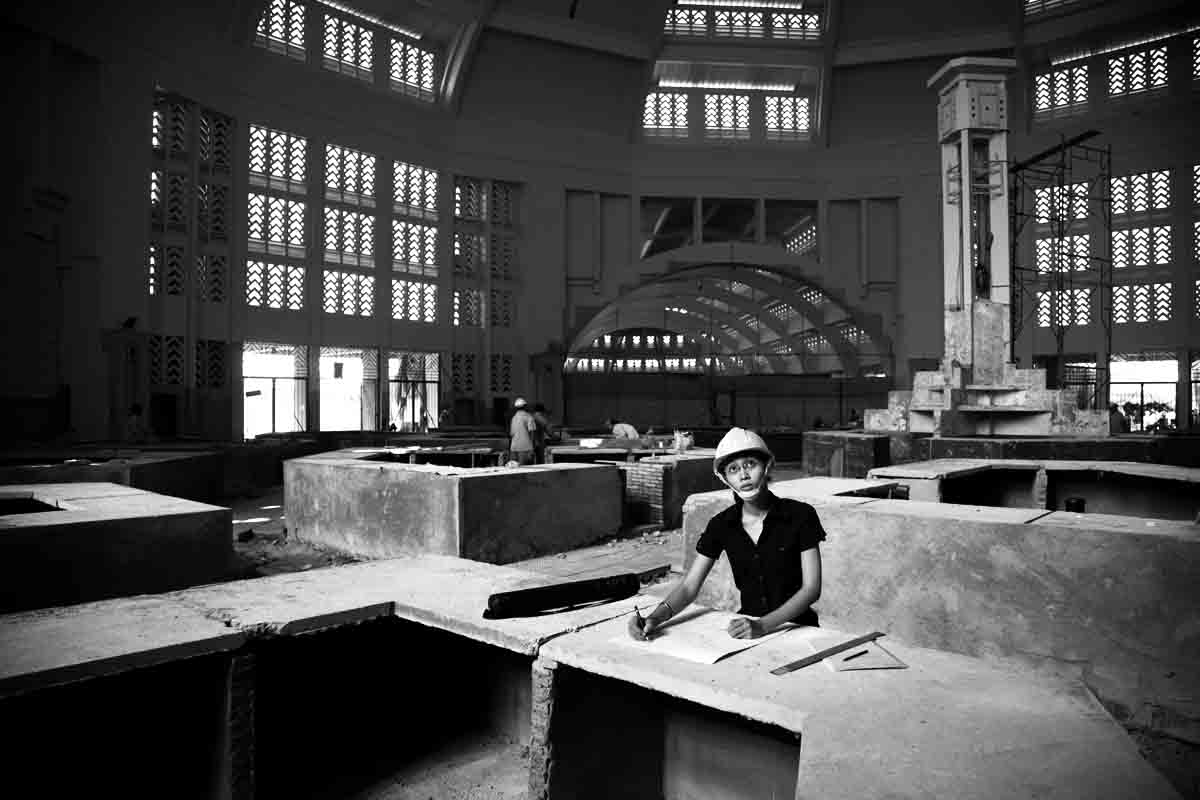“I feel really disappointed,” says Kim Hak. “Really upset; really angry.” The Phnom Penh-based photographer is talking about the destruction of old buildings in Cambodia to make way for profit-driven construction. He’s not unhappy that the nation’s economy has made room for high-rises, but keenly aware that “when the new buildings arrive, the old buildings start to be lost.” It’s an issue he addresses in his solo exhibition ON, which opens next week at Hazy Gallery in Le Poulinguen, France.
Kim began work for ON in 2008, thinking through the issues, and then in 2009 began undertaking detailed research both on site and in books. The exhibited images date from 2010. The project grew, says the artist, “from my worry about the destruction of the old buildings.” Like many contemporary artists in Cambodia, Kim’s practice is stridently documentary in approach and extensively researched. “I want to document them as memories,” he says of the old buildings, “in case they will be destroyed.”
Indeed, one building featured in the exhibition is no longer standing. “At the beginning of the work, I went to a building called Ecole Professional, just behind Chinese House,” Kim says. It was a grand French colonial structure, in a lovely riverside location. Although used as a warehouse to store medicine and rice since 1980, in 2009 the building became an exhibition space for the Phnom Penh Photo Festival.
“I went back one or two weeks after, and when I came back the guard said that I cannot go inside. And then it was destroyed less than one month later.” The site is now used as a garage.
Another building to disappear during Kim’s preparation was the Monivong Hospital. Sadly, it cannot be included in ON. “It was the plan to photograph it, but it was destroyed during my work before I could.” This is a particularly distressing loss for Kim, for two reasons.
Firstly, the building, which was near Sorya mall, used to be the state hospital and, as such, government property. But then the government sold Monivong Hospital to a private company, which was free to demolish it. The government is able to regulate and control development only on property that it owns. Through the Urban Heritage Mission working with the Ministry of Culture, Kim explains, public buildings can be preserved, but private property cannot, since “they don’t have the rule to control this.”
Since demolition, the site has lain empty – a second grave disappointment for Kim. “They just leave the land empty and not active,” he says, while they “wait until the price increases.” In a property market as pressured as Phnom Penh’s, there are significant profits to be made by investors willing to wait while land lies idle. Meanwhile, former residents – and in the case of the Monivong Hospital, patients – must fend for themselves in finding alternative accommodation. As the artist plainly states, “It’s a waste; a real waste.”
Kim’s focus is divided between colonial buildings and examples of the modernist New Khmer Architecture from the 1950s and 1960s. Both styles are widely appreciated, yet the artist has some important original insights to offer.
In France, where ON will be exhibited (and where Kim was awarded a prestigious prize in the 2011 Photo Quai contest), people “feel real pity” at the loss of this connection between France and its former colony. But for Kim, the stories that dwell in these buildings are emphatically Cambodian. “Even from the colonial time, it’s not built by colonial people; it’s built by local people.”
Similarly, New Khmer Architecture is celebrated because these buildings are “modern but still get inspiration from typical Khmer houses.” Cambodian architects such as Vann Molyvann – who trained with the French modernist master Le Corbusier – were a source of national pride and enjoyed international respect.
Kim is particularly interested in their environmental sensitivity. He observes that buildings made by Molyvann and his contemporaries “think about the way of the wind, the way of the light.” By contrast, new skyscraper constructions with their glass walls “don’t really adapt to the situation here…it’s hot outside.” The artist doesn’t mind development, “because people have different taste,” but when he sees windowless high-rises, he’s not happy.
ON is an exhibition as much about people as it is about buildings. Each image depicts an individual within a space, and Kim carefully selects these subjects. “They all have something to do with the building. Sometimes they lived in the building, or used to be a student or work there.” Others, such as the woman in the image from Central Market during its renovation, are architecture students from various Cambodian universities.
The artist takes inspiration from the people in his photographs. Channe, the woman shown in front of the lovely shutters of Preah Sisowath High School, was a former student in this 1933 structure. Now, she works in the tourism industry. “She wants old buildings to be cared [for] as much as possible,” Kim says, because they can be “attractive sites for tourists to visit” and perhaps even function as museums.
“Destroying old buildings is like killing groups of old people,” the artist powerfully declares. “When I think about the Khmer Rouge, when they kill people, they tied them… so they cannot fight against them, they just die.” The buildings are the same. They cannot talk. The people that own them should preserve them because the buildings cannot talk.”
With this exhibition, the artist captures and celebrates the generations of memories that live in Phnom Penh’s unique architecture. In his photographs, old buildings and their occupants are given a chance to speak. “Each building tells us different stories,” Kim says. Now, we’re paying attention.
WHO: Phnom Penh artist photographer Kim Hak
WHAT: ON
WHERE: Hazy Gallery, France, and at www.kimhak.com/on
WHEN: Exhibition opens 5 May
WHY: Because buildings can’t talk – or can they?
